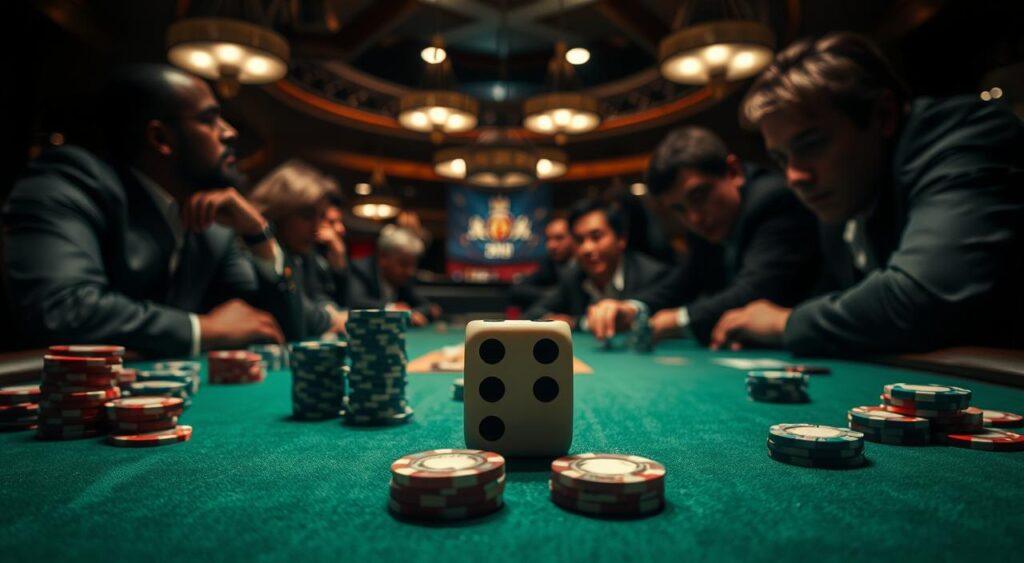Ever thought a coin is “due” to land on heads after five tails? That’s the gambler’s fallacy mental model. It’s a trap that psychologists like Daniel Kahneman have studied. It makes us think past random events affect the future.
This wrong thinking is common, from casinos to Wall Street. It tricks even the smartest people into believing in false patterns. It’s a powerful illusion that can lead us astray.
At its core, this bias makes us overestimate connections between unrelated events. A basketball player’s “hot streak,” a stock’s sudden drop after weeks of gains, or even waiting for a rainy day because “it hasn’t poured in weeks”—all stem from misreading probability. Our brains crave order, even when randomness rules.
Why does this happen? Evolution wired us to spot patterns for survival. But in modern life, that instinct backfires. We’ll explore how this illusion of control impacts decisions, why logic often loses to emotion, and practical ways to reset your thinking.
Key Takeaways
🎲 Random events don’t “balance out” over time—each outcome stands alone.
💸 The gambler’s fallacy mental model affects choices in finance, sports, and daily life.
🧠 Our brains naturally seek patterns, even where none exist.
🚫 Recognizing this bias helps avoid costly mistakes.
📊 Understanding true probability builds better decision-making skills.
Introduction to the Gambler’s Fallacy Mental Model
Ever doubled down on a lottery ticket because “your numbers are due”? This instinct reveals the gambler fallacy—a thinking error in gambling where we imagine past randomness shapes future odds and influences our understanding of probability.
Like assuming a roulette wheel “owes” red after ten blacks, it tricks us into seeing invisible rules in chance, reinforcing the fallacy that can increase our losses.
Definition and Basic Concepts
At its simplest, this cognitive bias distorts how we view probability. Each coin flip, dice roll, or stock shift operates independently. Yet our brains insist, “Three losses mean a win is coming!”—a belief as persistent as it is false.
Why It Captivates the Mind
We’re wired to spot patterns—a survival skill turned liability in random scenarios. Rain after a dry week feels inevitable. A basketball player’s hot streak seems destined. These illusions thrive on confirmation bias (noticing “proof”) and availability heuristic (recalling vivid examples).
Even smart people fall prey because emotion often overrides logic. The mind craves control, weaving stories where chaos reigns. Recognizing this tug-of-war helps separate real trends from imagined ones—a skill sharper than any lucky charm.
The Origins and Historical Context

Why do smart people still bet on “lucky streaks”? The answer lies in centuries of human struggle to understand probability and the gambler fallacy.
Long before probability became a science, ancient cultures saw patterns in weather, dice rolls, and stars—often mistaking coincidence for divine messages. This fallacy has been the subject of numerous articles that explore how misinformation can cloud our understanding of chance.
Early Mathematical Insights
Roman generals threw “lucky bones” before battles. Chinese scholars tracked celestial numbers to predict events. But true progress came when 16th-century mathematicians began studying dice games. Their work revealed a shocking truth: each roll exists independently, despite our craving for patterns.
| Era | Approach to Chance | Key Flaw |
|---|---|---|
| Ancient Times | Divination & rituals | Linked unrelated events |
| Renaissance | Dice probability studies | Limited real-world application |
| 18th Century | Formal probability theory | Public skepticism persisted |
Gamblers Fallacy Mental Model: The Legacy of Laplace
French mathematician Pierre-Simon Laplace changed everything in 1812. His book Théorie Analytique des Probabilités dismantled the myth that “tails must follow heads.” He proved coin flips have no memory—a concept still misunderstood today.
Laplace’s work faced resistance. People clung to the idea that probability “balances out.” Yet his evidence-based approach laid groundwork for modern statistics. It took 200 years, but we now have tools to separate real trends from imagined ones.
Understanding the Gamblers Fallacy Mental Model
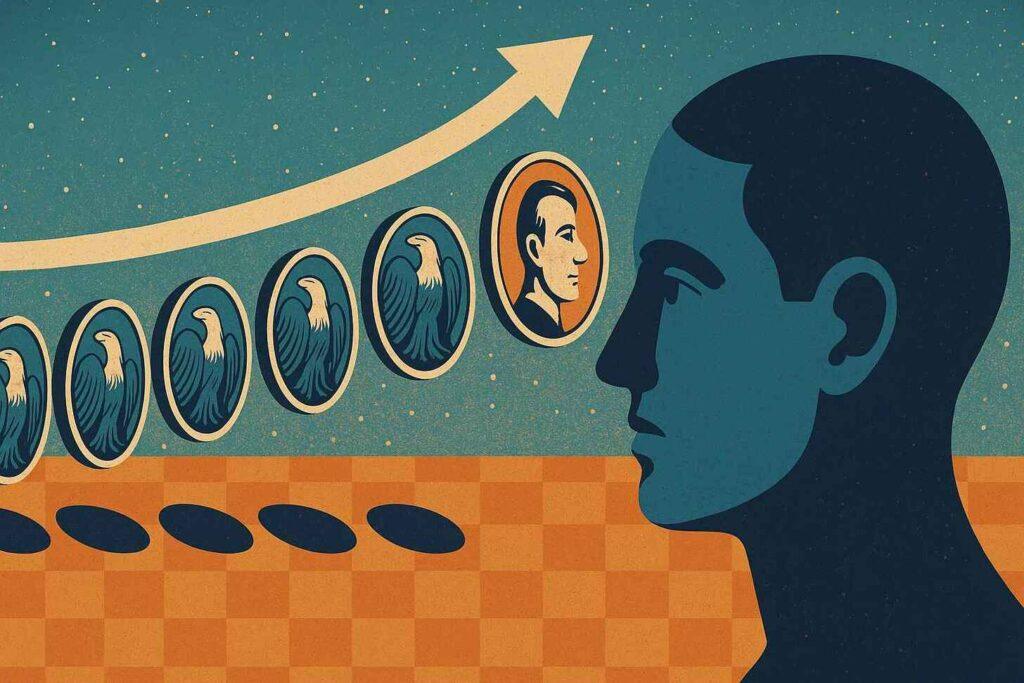
Randomness doesn’t play fair—it loves creating illusions of order. We often expect short-term outcomes in a series to mirror long-term averages, like assuming a coin must land heads after five tails.
This misbelief, a classic example of the gambler fallacy, fuels risky bets in casinos and everyday choices, tricking us into seeing balance where none exists. The information we gather often leads to flawed results, reinforcing our misconceptions.
Why “Evening Out” Feels So Intuitive
Humans are naturally drawn to balance. This comes from evolution, where spotting patterns was key to survival. Think about noticing animal tracks near water.
In today’s world, like investing or gambling, this instinct gets us into trouble. Psychologists say we use the representativeness heuristic. We think short sequences should mirror larger averages.
For instance, if a fair coin lands heads five times, we might think tails are next. But the odds haven’t changed. It feels odd to see long streaks of one outcome, yet math doesn’t agree with our sense of fairness.
Misinterpretation of Randomness
Our brains impose patterns on chaos. A roulette wheel hitting black seven times? “Red is due!” Lottery numbers repeating? “They’re cursed!” These reactions stem from a common cognitive trap where we treat unrelated events as connected. Each spin, flip, or deal operates independently—the past doesn’t whisper to the future.
Take slot machines. After ten losses, players often think a win is “building up.” But the machine’s algorithm has no memory. Like raindrops hitting pavement, each outcome exists alone. The Law of Large Numbers applies to trends over thousands of trials, not tonight’s lucky streak.
This confusion spills beyond gambling. Investors hold sinking stocks, convinced they’ll rebound “because they’ve fallen enough.” Parents plan outdoor weddings after three rainy Saturdays, trusting dry skies. Randomness thrives on clumps and gaps—recognizing this helps us make clearer choices.
Why do we struggle here? Evolution taught us to link causes to effects. But in true chance, there’s no referee keeping score. Acknowledging this blind spot builds smarter strategies—whether at poker tables or board meetings.
The Science of Probability and Random Events

Imagine flipping a coin ten times—each toss has the same 50% chance, yet we often feel a pattern emerging. This tension between math and intuition lies at the heart of understanding randomness. Let’s unpack how probability really works when events stand alone versus when they connect.
Independent vs. Dependent Events
Independent events operate like strangers passing on a street—they don’t influence each other. A roulette wheel landing on black seven times? The eighth spin still has 47.4% odds (in European roulette). Each outcome exists in its own moment, untouched by history.
Here’s the math: probability = favorable outcomes ÷ total possible outcomes. For dice, rolling a six stays 1/6 every time. But with dependent events—like drawing cards—probabilities shift. Pull a queen from a deck? Now only 3 remain among 51 cards.
| Event Type | Key Trait | Real-World Example |
|---|---|---|
| Independent | No memory | Coin flips, lottery numbers |
| Dependent | Changes odds | Card games, weather patterns |
Why does this matter? We often treat life like a slot machine—assuming losses increase future wins. But true probability theory shows each choice carries its own weight. Rain tomorrow doesn’t care if today was dry, just as stocks don’t “owe” rebounds after drops.
Our brains crave connections, but math reminds us: randomness plays by its own rules. Recognizing this helps separate hunches from hard numbers—whether you’re betting red or planning investments.
The Monte Carlo Casino Incident: A Landmark Example
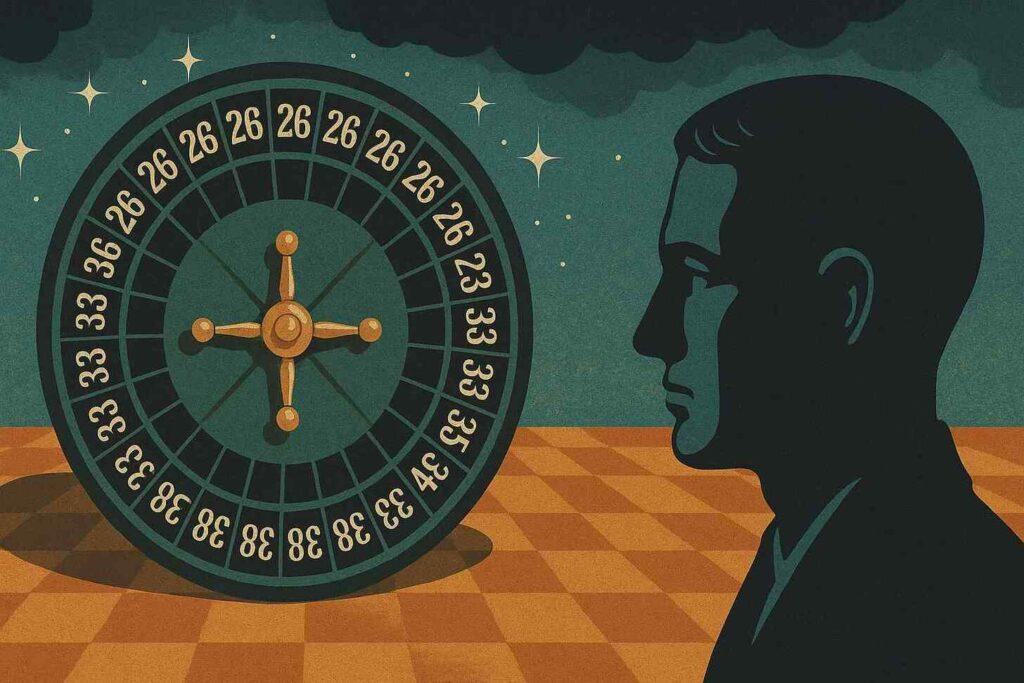
What happens when chance defies all expectations? The summer of 1913 at Monaco’s famed gaming halls answers this question through one unforgettable night.
Crowds gathered around a single roulette wheel as it delivered an unprecedented sequence—26 consecutive black results. This mathematical anomaly became the ultimate test of human reasoning under pressure.
26 Black Spins in a Row
Seasoned players doubled down on red with each spin, convinced the roulette wheel must “correct itself.” By the 15th black, bets reached fever pitch. Wealthy patrons poured money onto the table, certain their luck would turn. Yet probability remained unmoved—each spin held its 48.6% chance for black (European wheels have one zero).
The casino staff watched in disbelief as the streak continued. Players’ faces revealed the crushing weight of cognitive dissonance—their experience clashing with mathematical reality. This example shows how even experts misread randomness, treating independent events like chapters in a story.
Modern analysts calculate the odds of 26 blacks at roughly 1 in 66 million. But here’s the twist: any specific 26-spin sequence has identical odds. Our minds fixate on patterns we recognize, like repeated colors, while ignoring equally rare combinations that don’t look remarkable.
This casino legend teaches a vital lesson: streaks happen. Whether in games or life decisions, recognizing independent probabilities prevents costly assumptions. How might you respond if faced with such unexpected results?
Applications in Sports and Decision-Making

In high-stakes sports, split-second calls can shape careers—but hidden bias often influences outcomes. A 2008 study revealed tennis umpires became 15% less likely to call two consecutive faults, unconsciously avoiding back-to-back rulings.
This pattern mirrors decision making errors found in baseball umpires and loan officers, proving even experts misread randomness.
Tennis Umpires and Hidden Patterns
Researchers analyzed 4,000+ serves and found officials hesitated to penalize players twice in a row. After a fault call, the odds of a second violation dropped sharply—as if mistakes needed “recovery time.” This bias persists despite instant replay systems, showing how deeply we expect events to “balance out.”
Myth of the Hot Hand
Basketball fans cheer “He’s on fire!” after three baskets, while analysts track streaks. Yet studies show shooting slumps and surges often align with normal probability. A player hitting 50% from the field will naturally have clusters of makes and misses—no magic required.
| Perceived Pattern | Actual Cause | Impact on Choices |
|---|---|---|
| “Cold pitcher” | Random variation | Managers over-rotate rosters |
| “Lucky stadium” | Small sample size | Fans misplace bets |
| “Clutch gene” | Selective memory | Coaches favor veterans |
Sports betting markets thrive on these illusions. Bettors chase streaks, while oddsmakers profit from misread hot hand theories. Recognizing true randomness helps fans enjoy games without false narratives—and keeps wallets safer.
Cognitive Biases Underlying the Fallacy
Our brains are pattern detectives—always scanning for connections, even in chaos. This natural tendency to link events shapes how we interpret randomness, often leading us astray.
Two hidden forces drive these missteps: confirmation bias and the availability heuristic.
Confirmation Bias and the Availability Heuristic
Confirmation bias acts like mental blinders. Imagine an investor clinging to positive news about a failing stock while ignoring warning signs. We cherry-pick data that fits our beliefs, dismissing what doesn’t. It’s why people remember “near misses” in gambling but forget countless losses.
The availability heuristic makes vivid memories feel like common occurrences. After hearing about a plane crash, you might avoid flying—despite statistics showing it’s safer than driving. Recent or emotional events loom larger in our minds, distorting risk assessments.
| Bias | How It Works | Real-World Impact |
|---|---|---|
| Confirmation | Seeks supporting evidence | Holding losing investments too long |
| Availability | Overweights memorable events | Overestimating lottery win chances |
These cognitive biases evolved to help ancestors spot predators quickly. Today, they misfire in complex decision-making scenarios. Knowing about them isn’t enough—we must actively question our assumptions.
Next time you sense a “pattern,” ask: Am I ignoring contrary evidence? Are recent events skewing my judgment? Small pauses to reflect can reveal hidden biases steering your choices.
How the Gambler’s Fallacy Impacts Real-Life Decisions
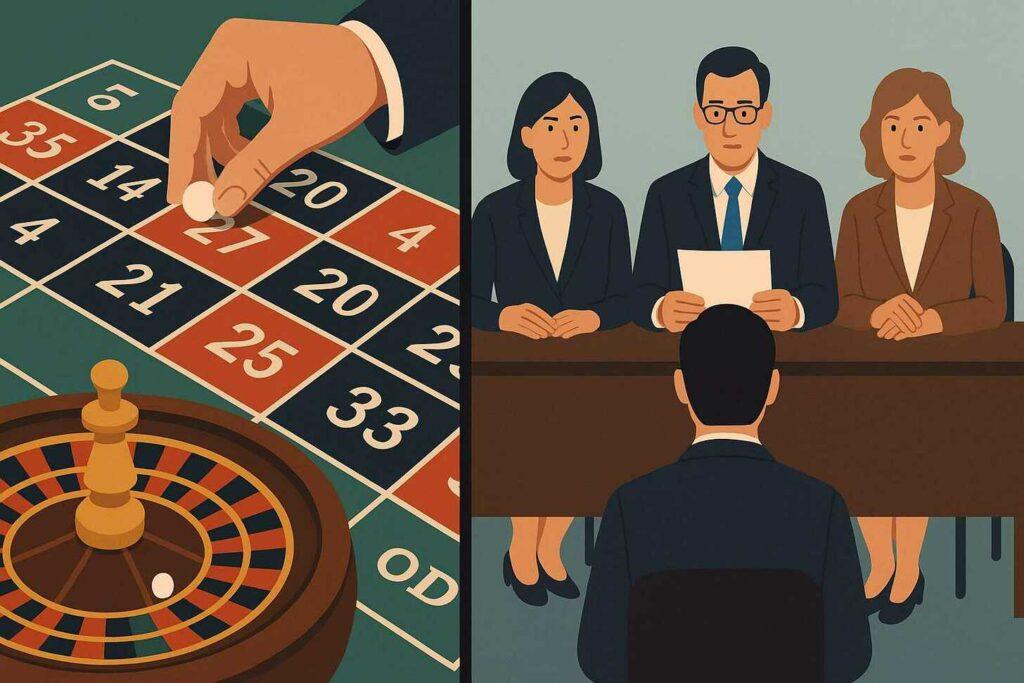
The gambler’s fallacy mental model isn’t just for casinos. It shows up in our daily choices, often without us realizing it. We might stay in a bad job, thinking “something good will happen soon.” Or, we might invest more, believing luck will turn our way.
This belief in balance where none exists can lead to poor decision-making. It affects many areas, like legal sentencing and hiring. A 2016 study in PNAS showed Israeli parole board decisions got softer after lunch. This suggests a mental reset, not a rational choice.
Understanding this fallacy can change how we make decisions. Each outcome should be judged on its own merit. By stopping the expectation of balance, we make better, more logical choices.
Psychological Influences on Gambling Behavior
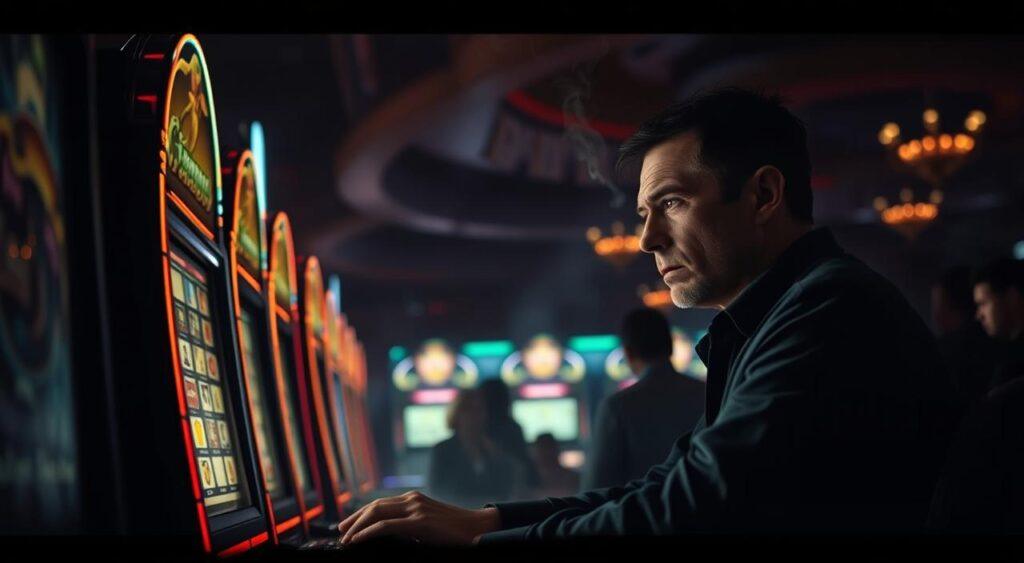
Why do slot machine players keep feeding coins after ten losses? The answer lies in a storm of emotions—hope whispering “next spin,” fear shouting “quit now,” and regret anchoring them to the chair. These forces shape choices more than probability charts ever could.
Slot Machines, Dopamine, and Design Psychology
Have you ever wondered why casinos keep you playing? Slot machines are made to tap into our emotions. When you almost win, it feels almost as good as winning for real.
This “almost winning” feeling releases dopamine in our brains. It’s like a reward, making us want to keep playing, even if we’re losing.
Studies at the University of British Columbia showed that near-misses make us play longer and bet more. We might know we’re losing, but the flashing lights and sounds keep us hooked. It’s all part of a clever strategy.
The Role of Emotions and Regret
Losing triggers a dangerous cocktail of feelings. Studies show people bet 23% faster after losses, chasing redemption. The psychology behind this? Our brains treat near-misses like wins, releasing dopamine that overrides logic. Casinos amplify this with flashing lights and celebratory sounds—even when you lose.
Regret becomes a silent partner in bad decisions. After five failed bets, many think: “I’ve come this far—walking away wastes previous efforts.” This “sunk cost” trap keeps players glued to seats, believing future luck must balance past misfortune.
| Emotion | Effect | Industry Exploitation |
|---|---|---|
| Hope | Clouds risk assessment | Free “bonus spins” offers |
| Fear | Triggers impulsive bets | Countdown timers on machines |
| Regret | Extends playtime | “Cash out now?” prompts |
Breaking this cycle starts with awareness. Setting time limits between decisions helps reset emotional states. Like waiting 10 minutes before placing another bet—cold water for overheated instincts.
How might your last choice have changed with a clear head? Sometimes walking away isn’t quitting—it’s winning the battle against invisible psychology traps.
Financial Decision-Making and Investment Risks
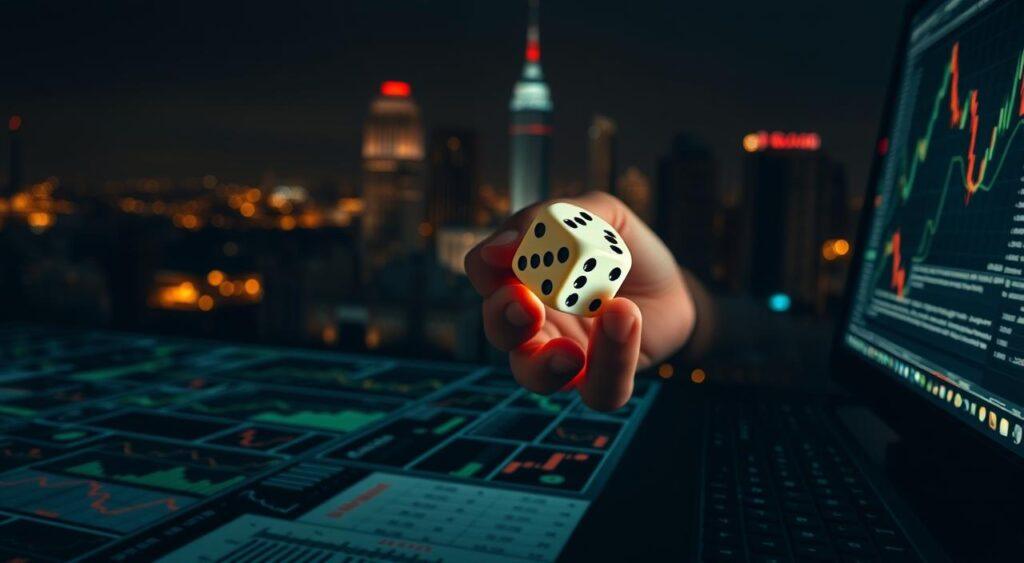
Ever held onto a sinking stock, convinced it’ll bounce back “because it can’t fall forever”? This mindset, akin to the gambler’s fallacy mental model, turns portfolios into rollercoasters.
Markets don’t keep score—each day’s price moves independently, yet we often treat them like chapters in a story, unaware of the risk uncertainty involved in our case and the potential result of our decisions.
Chasing Losses and Misguided Stock Bets
Investors frequently double down on declining assets, believing past losses increase future gains. But unless company fundamentals change, yesterday’s drop holds no power over tomorrow’s price. A stock down 20% this month has the same odds of rising as one up 30%.
| Common Mistake | Reality Check | Better Approach |
|---|---|---|
| “Averaging down” on weak stocks | Prices may keep falling | Set stop-loss limits |
| Holding losers too long | Emotional attachment clouds judgment | Review positions quarterly |
| Chasing “hot” sectors | Peaks often precede drops | Diversify across industries |
The disposition effect reveals our bias: selling winners early to lock gains while clinging to losers. Studies show this habit costs investors 1-4% annual returns. Why? We hate admitting mistakes more than losing money.
Professional traders aren’t immune. Hedge funds often over-trade after losses, trying to “make it back.” Systematic strategies like dollar-cost averaging help remove emotion from decision making. Automating investments creates discipline where human nature falters.
Next time you’re tempted to “ride out” a slump, ask: Would I buy this today at its current price? Honest answers often reveal hidden assumptions about risk and reward.
Mathematical Perspectives: Expected Value and the Law of Large Numbers

Math doesn’t lie—but our instincts often twist its truths. When facing uncertain choices, two concepts cut through confusion: expected value and the law of large numbers. These tools reveal why short-term luck rarely mirrors long-term trends.
Understanding Expected Value
Imagine planning a picnic. There’s a 30% chance of rain. Expected value weighs possible outcomes by their odds: sun (70% reward) vs. storm (30% risk). This weighted average guides smarter bets in life and finance. A coin flip’s expected value? Always 50/50—no matter last week’s results.
Clarifying the Law of Large Numbers
This theory states that averages stabilize over thousands of trials. Ten coin flips might show seven heads. A thousand flips? Likely near 500. But here’s the catch: short-term clusters—like three rainy weekends—are normal. They don’t violate math—they are math.
Think of weather patterns. A dry month doesn’t guarantee rain next week. Similarly, stock markets swing wildly daily but trend predictably over decades. Recognizing this separates hope from strategy.
How might you rethink decisions knowing streaks are part of probability’s design? Tools like expected value turn guesswork into grounded choices—one calculated step at a time.
Conclusion
The gambler’s fallacy mental model reveals how even the brightest can fall for randomness. It affects everyone, from casino players to business leaders, leading to poor choices and overconfidence. But recognizing this illusion gives us power.
Knowing that each event is independent of the past helps us make better decisions. This is true whether you’re investing, coaching, or just flipping a coin. Letting go of the idea of patterns is a key mental shift.
